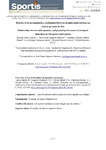Relación de la antropometría y rendimiento físico con la maduración biológica en tenistas juveniles de élite

Use este enlace para citar
http://hdl.handle.net/2183/38952
A non ser que se indique outra cousa, a licenza do ítem descríbese como Atribución-NoComercial-CompartirIgual 3.0 España
Coleccións
Metadatos
Mostrar o rexistro completo do ítemTítulo
Relación de la antropometría y rendimiento físico con la maduración biológica en tenistas juveniles de éliteTítulo(s) alternativo(s)
Relationship between anthropometry and physical performance by biological maturation in elite junior tennis playersAutor(es)
Data
2024-09-01Cita bibliográfica
López-García, R.; Lagunes-Carrasco, J.O.; Ochoa-Almed, F.A.; Carranza-García, L.E.; Navarro-Orocio, R.; Ramírez-Nava, R. (2024). Relación de la antropometría y rendimiento físico con la maduración biológica en tenistas juveniles de élite. Sportis Sci J, 10 (3), 417-436 https://doi.org/10.17979/sportis.2024.10.3.10542
Resumo
[Resumen]
El objetivo de este estudio fue analizar la asociación de la maduración biológica (MB)
con mediciones antropométricas y el rendimiento físico en tenistas juveniles de élite. Se
evaluaron 16 tenistas mujeres (14.12 ± 1.20 años de edad) y 17 tenistas hombres (13.76
± 1.20 años de edad) del ranking del Circuito Nacional Infanto-Juvenil de la Federación
Mexicana de Tenis. Se conformaron dos grupos, categoría 14 y categoría 16. Medidas
antropométricas y de rendimiento físico fueron evaluadas. Con la ecuación de Mirwald
et al. (2002) se obtuvo la MB. Los resultados mostraron diferencias de MB entre
categorías de varones. También, en los valores de peso, talla, IMC, longitudes
corporales, diámetro biestiloideo, diámetro biiliocrestal, grasa corporal, salto Abalakov
y lanzamientos de balón medicinal (p ≤ 0.05). En mujeres, no se encontraron diferencias
significativas entre las variables de rendimiento físico. La MB en la categoría 14-16 se
correlacionó con SJ, CMJ, Abalakov y LBC, acromial-radiale, biiliocrestal y porcentaje
de grasa (p ≤ 0.05) y en hombres la categoría 14 se asoció la prensión manual,
lanzamiento de balón por encima de la cabeza, longitudes óseas y el diámetro
biiliocrestal con la MB (p ≤ 0.05). La asociación entre la maduración biológica, las
medidas antropométricas y el rendimiento físico puede variar considerablemente entre
tenistas de diferentes categorías. No todos los tenistas en la misma etapa de maduración
biológica presentan las mismas características antropométricas o de rendimiento físico,
ya que otros factores como la genética, el entrenamiento y los hábitos de vida también
desempeñan un papel importante. [Abstract]
The aim of this study was to analyze the association of biological maturation (BM) with
anthropometric measurements and physical performance in elite junior tennis players.
Sixteen female (14.12 ± 1.20 years of age) and 17 male tennis players (13.76 ± 1.20
years of age) were evaluated from the ranking of the National Children's and Youth
Circuit of the Mexican Tennis Federation. Two groups were formed, U14 and U16.
Anthropometric and physical performance measures were evaluated. The equation of
Mirwald et al. (2002) was used to obtain the MB. The results showed differences in
MB between U14 and U16 male categories. Also, in the values of weight, height, BMI,
body length, biestiloideo diameter, biiliocrestal diameter, body fat, Abalakov jump and
medicine ball throws (p ≤ 0.05). In females, no significant differences were found
among the physical performance variables. MB in U14- U16 correlated with SJ, CMJ,
Abalakov and LBC, acromial-radiale, biiliocrestal and fat percentage (p ≤ 0.05) and in
males’ U14 hand grip, overhead ball throw, bone lengths and biiliocrestal diameter were
associated with MB (p ≤ 0.05). The association between biological maturation,
anthropometric measurements and physical performance can vary considerably among
tennis players of different categories. Not all tennis players at the same stage of
biological maturation have or show the same anthropometric or physical performance
characteristics, as other factors such as genetics, training and lifestyle habits also play
an important role.
Palabras chave
Deportista
Categoría
Pruebas físicas
Longitudes óseas
Crecimiento
Athlete
Category
Physical tests
Bone length
Growth.
Categoría
Pruebas físicas
Longitudes óseas
Crecimiento
Athlete
Category
Physical tests
Bone length
Growth.
Versión do editor
Dereitos
Atribución-NoComercial-CompartirIgual 3.0 España
ISSN
2386-8333






